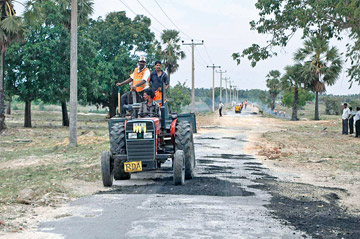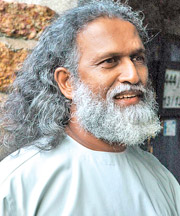Development jab for North-East
Nipuni WIMALAPALA
|

The development process must be continued in an environmental
friendly manner
|
After many years of conflict and economic, social, cultural collapse,
the Northern and Eastern provinces are opening up for development with
increased investments in road and building construction,
telecommunication and reestablishment of public administration to
stimulate investment and growth in a sustainable manner.
This new era of development is up against the issue of scares natural
resources which are precious as well as essential for the developmental
process itself.
According to Additional secretary, Regional Development, Economic
Development Ministry, Nihal Somaweera, the ministry has already
undertaken demining, housing for IDPs, infrastructure development, water
supply, construction of fisheries harbours, several major road projects,
reestablishment of government buildings, Jaffna power transmitting
project and many other smaller projects.
In an interview with Daily News he revealed that the government has
spent a large amount of money starting from last year, on development.
“There are many development projects on going and nine out of ten are in
the North and East.”
Minimizing adverse effects
However different issues emerge in a development process. “The major
problem is how to reduce the environmental impact of development,” said
Nihal Somaweera. It is obvious that the negative effects on the
environment cannot be totally eliminated and development cannot be put
on hold to preserve natural resources. “We have to work out the best way
to minimize adverse effects on the environment.”
The Central Environmental Authority (CEA) has done a Strategic
Environmental Assessment (SEA) which includes all issues regarding
environment and how to mitigate the negative impacts of development on
the environment,” said Somaweera.
The different partners in the process contribute to minimize the
negative effects. “We are observing the sanctuaries and other
environmentally significant sites in the region. We prioritize the most
valuable areas and take steps to conserve them.”
He said that the SEA keeps a tab on the forest cover, archaeological
sites, wild life and wetlands that are to be conserved.
Scientific methods

Some of the sanctuary lands belong to civilians who lived there
before war broke out. Now they are reverting to their old way of
life and want their own lands back.
This badly affects the bird life for which the sanctuaries were
designated in the first place.
- Prof Sarath Kotagama
|
The Economic Development Ministry has
undertaken demining, housing for IDPs, infrastructure
development, water supply, construction of fisheries harbours,
several major road projects, reestablishment of government
buildings,
Jaffna power transmitting project and
many other smaller projects There are many development projects
on going and nine out of ten are in the North and East
- Nihal Somaweera
|

Areas of high environmental value in the North and East, such as
elephant corridors, should remain untouched
scientific methods can play
a major role in north-east
development. Unique
geographical features
of the island re-enforce
the development process
- Dr Ananda Mallawatantri |
According to Assistant Resident Representative, Team leader of
Environment, Energy and Disaster management, UNDP Sri Lanka, Dr Ananda
Mallawatantri, scientific methods can play a major role in north-east
development. Unique geographical features of the island re-enforce the
development process.
“Obviously, we cannot preserve all the resources as they are now, but
we still can minimize the harm.” Dr Mallawatantri explained that the
areas of high environmental value in the North and East should remain
untouched. “This is why we have to first prioritize resources. For
example, elephant corridors are highly sensitive areas that must not be
meddled with.”
According to him, this is the ideal time for development, after
overcoming the three decade old war. “Development is really essential in
the North and East. Now we are experiencing a new era in which
development has become a must.”
He also emphasises the fact that it is not a simple process and
should be conducted scientifically. “There must be scientific researches
in order to find out the best places to be utilised for developmental
activity.” Another essential factor is educating the people living in
these areas.
Stakeholders
“A scientific method of development requires a lot of input.” He
explained that there are many stakeholders in the process, such as the
Economic Development Ministry, Environmental Ministry, Disaster
Management Ministry, Resettlement Ministry, Defense Ministry,
Archaeology Department, Board of Investment of Sri Lanka, Central
Environmental Authority, Wildlife Conservation Department and Forest
Department among others.
“In most cases there can occur conflicts between their different
plans. It is necessary to resolve these conflicts and to come up with a
unanimous resolution,” said Dr Mallawatantri.
Central Environmental Authority undertakes mitigation of negative
environmental impacts. Integrated Strategic Environmental Assessment is
the key tool used to carry out sustainable development.
It is concerned with finding answers to basic but essential questions
such as whether there is sufficient ground and surface water for
industry and human settlement, what building material could be sourced,
which forests, coastal, wildlife, wetland and archaeological sites
should be conserved, how would this add value to the proposed
development plans, especially tourism in the area.
In the process of seeking answers to these issues, the Integrated
Strategic Environment Assessments (ISEA) will create space for greater
engagement of all stakeholders in a process of informed decision making
on the sustainable use of the natural resource base for accelerated
development.
According to Mallawathantri, Sri Lanka has unique possibilities to
promote development while conserving natural resources.
“We have prepared different types of maps for easy identification of
geographic areas that highlight importance of resources.” He says that
these maps facilitate sustainable development.
Land ownership
According to the Head of Zoology Department, University of Colombo
Prof Sarath Kotagama, the development process in Northern and Eastern
provinces should be long term. “It needs at least 10 years,” says Prof
Kotagama.
Concurring what Dr Mallawathantri said, Prof Kotagama says that the
ISEA is the best method and should be properly administered in order to
reach a sustainable development. “There are many environmental issues.
It is necessary to consider them in a sensitive and a scientific
manner,” said Prof Kotagama.
Prof Kotagama identifies land ownership issues as one of the major
problems. Private property cannot be used for government projects.
Another serious issue is that the newly designated sanctuaries such as
the Vankalai are under immediate threat.
“Some of the sanctuary lands belong to civilians who lived there
before war broke out. Now they are reverting to their old way of life
and want their own lands back,” explained Prof Kotagama. This badly
affects the bird life for which the sanctuaries were designated in the
first place. He reiterated the importance of making well informed
decisions regarding the issue of land ownership.
Unplanned structures
North and East are highly damaged areas. Many large scale
construction projects have already commenced. Prof Kotagama explained
that unplanned structures pose a threat to the natural environment.
“Moreover the social set up in these areas is very different. People
must be educated on what is taking place.” Garbage is another major
environmental hazard in the North and East. There are huge amounts of
garbage especially in Jaffna. Garbage disposed of by travellers create
considerable pollution.
“This should be stopped. Railway construction is to start soon and
forests obviously have to be cut down. But this must be done in a
systematic and sustainable manner,” says Prof Kotagama.
Development is a must in the North and East so is minimizing
environmental degradation. The development process must be continued in
an environmental friendly manner. |



